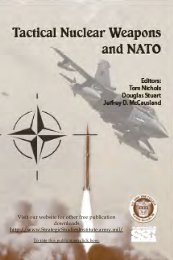Revisiting the Dove's Dilemma: - Program on Strategic Stability ...
Revisiting the Dove's Dilemma: - Program on Strategic Stability ...
Revisiting the Dove's Dilemma: - Program on Strategic Stability ...
You also want an ePaper? Increase the reach of your titles
YUMPU automatically turns print PDFs into web optimized ePapers that Google loves.
Ericks<strong>on</strong> and Way, “Doves <str<strong>on</strong>g>Dilemma</str<strong>on</strong>g>”<br />
war. And, most importantly, countries pursuing nuclear weap<strong>on</strong>s received notably greater<br />
c<strong>on</strong>venti<strong>on</strong>al arms transfers, even after c<strong>on</strong>diti<strong>on</strong>ing <strong>on</strong> <str<strong>on</strong>g>the</str<strong>on</strong>g>ir security envir<strong>on</strong>ment.<br />
In <str<strong>on</strong>g>the</str<strong>on</strong>g>se models, our dependent variable is in logs whereas <str<strong>on</strong>g>the</str<strong>on</strong>g> explanatory variables are<br />
not (that is, <str<strong>on</strong>g>the</str<strong>on</strong>g>se are semi-logarithmic equati<strong>on</strong>s), meaning <str<strong>on</strong>g>the</str<strong>on</strong>g> coefficients can be read as partial<br />
elasticities: <str<strong>on</strong>g>the</str<strong>on</strong>g> coefficient indicates roughly <str<strong>on</strong>g>the</str<strong>on</strong>g> approximate percentage change in arms transfers<br />
for a <strong>on</strong>e unit change in <str<strong>on</strong>g>the</str<strong>on</strong>g> explanatory variable. For example, <str<strong>on</strong>g>the</str<strong>on</strong>g> model in column <strong>on</strong>e<br />
indicates that countries pursuing nuclear weap<strong>on</strong>s receive roughly 77% more in arms transfers<br />
than those that are not pursuing nukes. 20 Similarly, participati<strong>on</strong> in an enduring rivalry also has a<br />
substantively significant effect: countries in a rivalry receive roughly 83% more arms than o<str<strong>on</strong>g>the</str<strong>on</strong>g>r<br />
countries. Clearly, states that are pursuing nuclear weap<strong>on</strong>s do not, in general, become pariahs of<br />
<str<strong>on</strong>g>the</str<strong>on</strong>g> internati<strong>on</strong>al arms market. In fact, <str<strong>on</strong>g>the</str<strong>on</strong>g>y receive more than <strong>on</strong>e would expect c<strong>on</strong>diti<strong>on</strong>al <strong>on</strong><br />
<str<strong>on</strong>g>the</str<strong>on</strong>g>ir general security situati<strong>on</strong>. Interestingly, this ―b<strong>on</strong>us‖ seems to vanish if <str<strong>on</strong>g>the</str<strong>on</strong>g>y actually cross<br />
<str<strong>on</strong>g>the</str<strong>on</strong>g> nuclear threshold and acquire nuclear weap<strong>on</strong>s. The model in column 3 suggests than when<br />
pursuing weap<strong>on</strong>s, countries import 108% more weap<strong>on</strong>s than would o<str<strong>on</strong>g>the</str<strong>on</strong>g>rwise be expected;<br />
however, <strong>on</strong>ce <str<strong>on</strong>g>the</str<strong>on</strong>g>y cross <str<strong>on</strong>g>the</str<strong>on</strong>g> threshold and possess nuclear weap<strong>on</strong>s, <str<strong>on</strong>g>the</str<strong>on</strong>g>ir import propensity<br />
becomes indistinguishable from that of o<str<strong>on</strong>g>the</str<strong>on</strong>g>r states in similar security envir<strong>on</strong>ments. Yet states<br />
also do not in <str<strong>on</strong>g>the</str<strong>on</strong>g> aggregate get punished – in terms of reduced access to c<strong>on</strong>venti<strong>on</strong>al arms – for<br />
pursuing nuclear weap<strong>on</strong>s. We explore <str<strong>on</strong>g>the</str<strong>on</strong>g> reas<strong>on</strong>s for this intriguing pattern in our case studies.<br />
This finding is not sensitive to <str<strong>on</strong>g>the</str<strong>on</strong>g> particular coding of nuclear weap<strong>on</strong>s program. Although <str<strong>on</strong>g>the</str<strong>on</strong>g><br />
results reported above are based <strong>on</strong> <str<strong>on</strong>g>the</str<strong>on</strong>g> updated versi<strong>on</strong> of <str<strong>on</strong>g>the</str<strong>on</strong>g> Singh and Way codings, results<br />
20 The coefficients in <str<strong>on</strong>g>the</str<strong>on</strong>g> table can be read as a rough approximati<strong>on</strong> of <str<strong>on</strong>g>the</str<strong>on</strong>g> partial elasticity, but as values increase<br />
in size <str<strong>on</strong>g>the</str<strong>on</strong>g> approximati<strong>on</strong> becomes progressively less accurate. The precise proporti<strong>on</strong>al change in <str<strong>on</strong>g>the</str<strong>on</strong>g> outcome<br />
variable resulting from a n<strong>on</strong>-infinitesimal change in <str<strong>on</strong>g>the</str<strong>on</strong>g> explanatory variable is calculated as exp(bΔX) – 1 (<str<strong>on</strong>g>the</str<strong>on</strong>g><br />
percentage change reported in <str<strong>on</strong>g>the</str<strong>on</strong>g> text multiplies this result by 100). Thornt<strong>on</strong> and Innes (Thornt<strong>on</strong> and Innes 1989)<br />
provide a careful explanati<strong>on</strong> of <str<strong>on</strong>g>the</str<strong>on</strong>g> proper interpretati<strong>on</strong> of semi-logarithmic regressi<strong>on</strong>s.<br />
18








